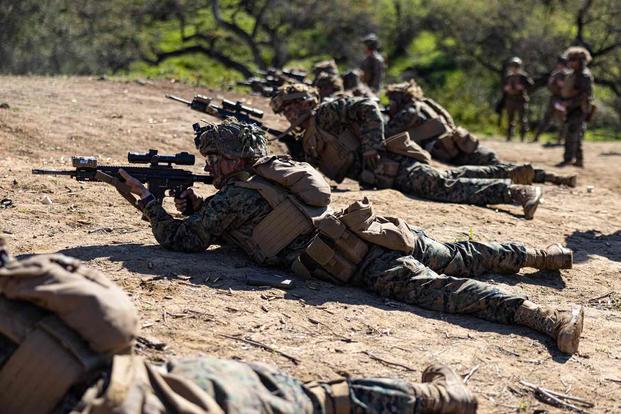Marine Corps infantry battalions are set to shrink by almost 10% this fall.
The service's "Force Design 2030" initiative -- a planned transformation of the Marine Corps this decade that has drawn controversy in the past -- will shave the current infantry battalion size from 900 down to 811 by September.
Marine leaders hope to right-size units after the wars in Iraq and Afghanistan and adapt the Corps for a more diffuse 21st century battlefield. Specifically, they want to overcome the challenges of keeping units supplied in the Indo-Pacific region as those units grow in size and complexity.
Read Next: Feds Sue for Millions in Damages After Osprey Incident at San Diego Airport
And a Marine unit that's too big to keep supplied isn't a unit any more.
"My No. 1 focus: logistics, logistics, logistics," Gen. David Berger, commandant of the Marine Corps, said during a talk at the Brookings Institution think tank in May.
Bringing the size of infantry units down is a key part of maximizing the ability to keep troops fighting no matter where they are. "We need to be more naval, more light, and more distributed in order to deter better and be able to respond faster," Berger said. "The concept drove everything else."
Joslyn Fleming, a defense policy researcher at Rand Corp. who has a background in Marine Corps logistics, told Military.com that making the Corps lighter and smaller would make it easier to deploy or redeploy during war creating a more nimble and reactive force.
Another reason for reducing the size of battalions? Some of those units aren't at full strength as they are, and a certain amount of force reduction is just acknowledging the Marine Corps as it exists, rather than fielding a military that's some percentage notional.
"Part of this is to consolidate," said Fleming. "You can fully staff these units to 100%."
But adjustments like this have been controversial. As reported by various outlets including Military.com, many current and former Marine leaders see the FD 2030 plan as weakening the Corps.
Prominent former officers have argued strenuously against adopting various parts of the plan. Those critics pay special attention to opposing the elimination of tanks, or reducing Marine infantry combat power.
"The Marine Corps armored capability significantly weighs you down," Fleming said. "Part of what Berger wants is for the Marine Corps to return to its naval heritage and its naval roots. You can only fit so many tanks on naval shipping, and they take up quite a bit of space and quite a bit of cubic weight."
While the controversy is often framed in terms of what is being lost, Fleming said that it would be better to think about it in terms of what is being gained, and that the ultimate size of the Corps would be one that was optimally capable.
"This new, smaller Marine Corps will need to be a very well-trained, mature, almost special operations forces-style force," said Fleming. "By shrinking in some areas, they'll be able to invest in other capabilities that are already emerging in today's war zones."
-- Adrian Bonenberger, an Army veteran and graduate of the Columbia University Graduate School of Journalism, reports for Military.com. He can be reached at adrian.bonenberger@monster.com.
Related: After a Barrage of Editorials and Critiques, Marine Leaders Defend Restructuring Plan











